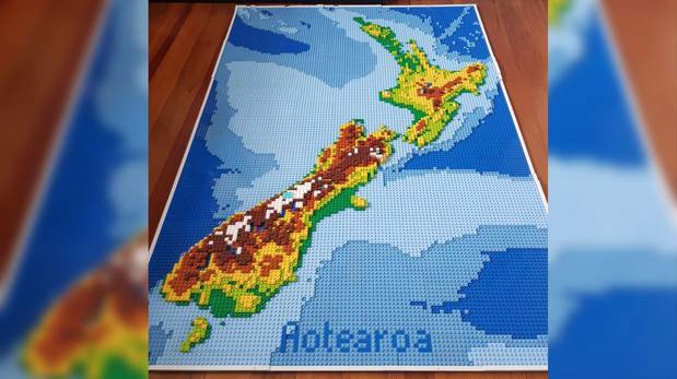
A data analyst who spent months creating a mini version of a New Zealand map with Lego has revealed how he made the masterpiece possible.
German Alex Waleczek, who lives in New Zealand, used 3800 bricks and Linz data to make an accurate 3D model of a map of New Zealand.
The map is to the scale of 1:125000, with the finished model sized 90cm x 128cm x 3.3cm and weighing 7.8kg.
Waleczek told the Herald the idea sparked from both getting a Lego set for Christmas and previous unrelated data work he had done earlier on a New Zealand map.
After exploring a geospatial tool, he found that the digital maps looked a lot like Lego bricks and from there, things came together.
He did some research and found other Lego maps online before he began his quest to make his masterpiece.
With the help of Dirk, who made a Lego world map to scale, Waleczek used a geographic information system, QGIS, to plan out the map using data from Linz.
Writing in his blog, the data analyst said he wanted to make sure that he represented the data in a way that makes sense to all and was accurate.
He decided to make each brick represent 10km in the real world which resulted in a scale of 1:1250000.
Waleczek also used colours to match the standard colour scheme for elevation maps, which go from green to yellow to brown and white and came up with a formula for showing the different depths across New Zealand.
/arc-anglerfish-syd-prod-nzme.s3.amazonaws.com/public/KRYN46OIBVAWBOUPA533RRFRWM.jpg)
After making three different models, he then used a virtual Lego builder, Stud.io, which has (virtually) every brick ever produced by Lego and all of the possible colours.
"You pick a brick one by one and stack them on top of each other to build whatever you desire," Waleczek wrote in his blog.
"It then integrates with bricklink.com, an online marketplace where people sell their Lego brick by brick, so once the model is finished, it only takes a few clicks to order the bricks you need [in theory!]."
However, Waleczek found that even though Bricklink shows which shops sell the cheapest bricks, it didn't take shipping fees into account.
/arc-anglerfish-syd-prod-nzme.s3.amazonaws.com/public/OFLWLQPZJZERZPCARRFW5JIWLI.jpg)
He ended up making 12 different orders from Europe and had them locally shipped to his family in Germany before getting them to send the orders in bulk — saving him up to $500.
Waleczek was concerned the Lego pieces wouldn't turn up because of the Covid-19 lockdown, but was happy that they eventually did.
The data analyst ended spending around 100 hours planning and working on the map since the end of January and ended up finishing it last weekend.
"It actually looks a lot better than I thought it would come. All the details came out quite nicely," he said.
"I am very happy with how the map turned out."
One of the biggest challenges he faced was the technical side of planning and creating the map.
"It's not too difficult if you know what you're doing — but I didn't," he said.
/arc-anglerfish-syd-prod-nzme.s3.amazonaws.com/public/KWLN54GAVVHKBDYAAY5E2CX3JQ.jpg)
"I didn't know anything about [making a Lego map], so it was a lot of learning by doing."
Another challenge he encountered was the size of the map as he wanted to hang it on a wall.
He said they didn't have a lot of wall space in his home and he spent some time finding a place for his masterpiece.
But after making three different sized models, he decided to go with the large one as it looked better and it also fitted on his living room wall.
"Once the lockdown is over I need to get some materials to hang it."
/arc-anglerfish-syd-prod-nzme.s3.amazonaws.com/public/DIS3COH6SRG45JEHC7IJHDBI7Q.jpg)
Waleczek wanted to give a shout out to Linz for the super-detailed data it provides to the public and commended it for also having seafloor elevation data which he wasn't expecting.
He said he had no specific ideas for his next Lego model but is waiting for inspiration to strike.
For more detailed information about Waleczek's process, read his blog.
Take your Radio, Podcasts and Music with you









